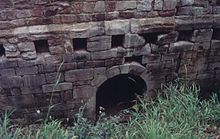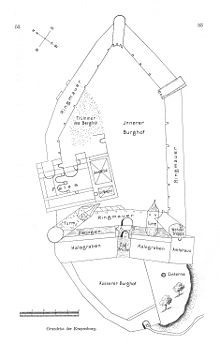Krayenburg
| Krayenburg | ||
|---|---|---|
|
North wall of the ruins of the Palas |
||
| Alternative name (s): | Crayenberg | |
| Creation time : | 1150? | |
| Castle type : | Summit castle | |
| Conservation status: | ruin | |
| Standing position : | Count | |
| Construction: | Ashlar wall | |
| Place: | Depth location | |
| Geographical location | 50 ° 50 '13 " N , 10 ° 7' 45" E | |
| Height: | 428.3 m above sea level NN | |
|
|
||
The Krayenburg is a castle ruin in the Tiefenort district in the Wartburg district in Thuringia , which was first mentioned in 1155 .
location
The ruin of the summit castle is at 428.3 m above sea level. NN on the now forested, widely visible summit of the conical Krayenberg protruding from the Werra Valley , which runs steeply into the valley on three sides and is only accessible by vehicles from the east via a 1500 m long driveway from Tiefenort. There are also some hiking trails from Merkers and Kieselbach .
history
The Krayenburg is one of the oldest stone castles in the Werra Valley , it was probably built on the site of a pagan mountain sanctuary.
Wallburg
In the 8th century, Charlemagne donated properties in Dorndorf and the surrounding area to the Hersfeld Monastery , which had to be protected by fortifications. On the ridge, about 200 m east of the castle, there are still clearly recognizable remains of an older hill fort, which may still come from prehistoric times.
Hersfeld castle complex
The Krayenburg is first mentioned in 1155 as the "castrum" of the Hersfeld monastery. The noble family von Frankenstein held the castle as a Hersfeld fief and expanded it into one of the most important Romanesque complexes in the central Werra valley. In 1184, Emperor Friedrich I Barbarossa confirmed ownership. The castle was held in high esteem in the empire and was a place of asylum . In 1270 the castle offered Margaretha von Staufen , a daughter of Emperor Frederick II , refuge when she fled from the Wartburg after the breakdown of her marriage to Albrecht II .
Protective bailiwick of the Frauensee monastery
Within sight of the castle, the Frauensee monastery was built in an extensive, sparsely populated forest area north of the castle. The Krayenburg was also designated to protect this important Cistercian nunnery. After a dispute with the Fulda Monastery , the Lords of Frankenstein lost their feudal rights to the castle, which subsequently changed hands frequently. In 1407, the Hersfeld monastery pledged the Krayenburg and surrounding properties to the Thuringian landgraves. In 1567 it came to the Ernestine Duchy of Saxony and after further division of the country from 1596 it belonged to the Duchy of Saxony-Eisenach and later to the Duchy of Saxony-Weimar-Eisenach .
Residence of the Counts of Beichlingen
The Counts of Beichlingen , who took over the castle from 1516 to 1567 as feudal owners, had previously held an autonomous petty lordship in Innerthuringia. The Krayenburg was her last residence. From 1567 to 1879 the castle was also the seat of the " Office Kraynburg ". The Krayenburg itself became a ruin in the Thirty Years' War .
Decay of the castle complex
In 1640 Croatian imperial troops invaded the castle and plundered it. After that it fell into disrepair and was used as a quarry for the needs of the population. In 1703 the official seat was moved to Tiefenort , only a forester remained in the walls.
Goethe visited Krayenburg in 1782 and drew it. At that time only ruins were left of the mighty Romanesque complex. In 1850 the Romanesque columns were removed from the windows of the hall and placed in the commandant's garden of the Wartburg . Today only small remains of the original building stock are preserved. Parts of the Palas , the inner and outer annular wall of the basement, as well as a cistern have survived the centuries.
Krayenburg Association
The Krayenburggemeinde association built a hermitage on the site in the 1920s, a sandstone building with a hall and accommodation, as well as a round observation tower that was extended several times. After the castle became "public property" after the Second World War and the municipality of Krayenburg was dissolved under state pressure, it served as a party school and youth work center during the GDR era . A striking Post transmitter was built on the mountain. After the reunification, the association was re-established and made a decisive contribution to the renovation and expansion of the castle as a restaurant and hotel.
Redevelopment
The ruins of the palace became statically unstable as a result of centuries of structural neglect and had to be stabilized in the 1990s, during which the first excavations and investigations were carried out. In the northern part of the castle complex, further transmission systems were built.
Structural remains
Several cellar vaults and the palace , which is still present with the north wall, have been preserved from the castle complex . Furthermore, remains of a staggered section fortification can be found on the access road, rampart and moat of the core castle . The castle site is now a ground and architectural monument in the municipality of Tiefenort.
literature
- Thomas Bienert: Medieval castles in Thuringia. 430 castles, castle ruins and fortifications. Wartberg-Verlag, Gudensberg-Gleichen 2000, ISBN 3-86134-631-1 , p. 328f .: Merkers-Kieselbach, Krayenburg ruin.
- Peter Drescher : Tiefenort on the Werra. From then until now. Geiger, Horb am Neckar 1999, ISBN 3-89570-549-7 , pp. 11–31.
- Krayenburggemeinde (Hrsg.): The Krayenberg with the Krayenburg. Mayor's Office of the Krayenburg Community, Tiefenort 1929.
- Werner Stranz (Red.): 850 years of Kieselbach. 1155-2005. Jubilee Association Kieselbach 1155 eV, Kieselbach 2005 (Festschrift).
Individual evidence
- ^ Georg Kühn: Addendum to the prehistoric hill fort. In: G. Voss: District court districts Vacha, Geisa, Stadtlengsfeld, Kaltennordheim and Ostheim vd Rhön. (Dermbach administrative district) (= architectural and art monuments of Thuringia. 1: Grand Duchy of Saxony-Weimar-Eisenach ). Volume 4 = Issue 37. Fischer, Jena 1911, p. 301 .
- ^ History of the castle and office of Krayenburg
- ^ Georg Kühn: Krayenburg. In: G. Voss: District court districts Vacha, Geisa, Stadtlengsfeld, Kaltennordheim and Ostheim vd Rhön. (Dermbach administrative district) (= architectural and art monuments of Thuringia. 1: Grand Duchy of Saxony-Weimar-Eisenach ). Volume 4 = Issue 37. Fischer, Jena 1911, pp. 47-55 , pp. 61-69 .
Web links
- Krayenburg website
- Article with the title “The Krayenburg and its connection to the Reichsabtei Hersfeld, Part I” from the supplement “Mein Heimatland” of the Hersfelder Zeitung
- Article with the title “The Krayenburg and its connection to the Reichsabtei Hersfeld, Part II” from the supplement “Mein Heimatland” of the Hersfelder Zeitung






